 IIA MRIDWEEKA SINGH
IIA MRIDWEEKA SINGHSN 2018is: a low-luminosity type IIP supernova with narrow hydrogen emission lines at early phases
We present a comprehensive photometric and spectroscopic study of the Type IIP supernova (SN) 2018is. The V band luminosity and the expansion velocity at 50 days post-explosion are −15.1 ± 0.2 mag (corrected for AV = 1.34 mag) and 1400 km s−1, classifying it as a low-luminosity SN II. The recombination phase in the V band is shorter, lasting around 110 days, and exhibits a steeper decline (1.0 mag per 100 days) compared to most other low-luminosity SNe II. Additionally, the optical and near-infrared spectra display hydrogen emission lines that are strikingly narrow, even for this class. The Fe II and Sc II line velocities are at the lower end of the typical range for low-luminosity SNe II. Semi-analytical modelling of the bolometric light curve suggests an ejecta mass of ∼8 M⊙, corresponding to a pre-supernova mass of ∼9.5 M⊙, and an explosion energy of ∼0.40 × 1051 erg. Hydrodynamical modelling further indicates that the progenitor had a zero-age main sequence mass of 9 M⊙, coupled with a low explosion energy of 0.19 × 1051 erg. The nebular spectrum reveals weak [O I] λλ6300,6364 lines, consistent with a moderate-mass progenitor, while features typical of Fe core-collapse events, such as He I, [C I], and Fe I, are indiscernible. However, the redder colours and low ratio of Ni to Fe abundance do not support an electron-capture scenario either. As a low-luminosity SN II with an atypically steep decline during the photospheric phase and remarkably narrow emission lines, SN 2018is contributes to the diversity observed within this population.
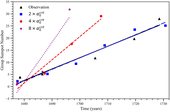 IIA PAWAN KUMAR, S
IIA PAWAN KUMAR, SAnalyses of features of magnetic cycles at different amounts of dynamo supercriticality: solar dynamo is about two times critical
The growth of a large-scale magnetic field in the Sun and stars is usually possible when the dynamo number (D) is above a critical value Dc. As the star ages, its rotation rate and thus D decrease. Hence, the question is how far the solar dynamo is from the critical dynamo transition. To answer this question, we have performed a set of simulations using Babcock Leighton type dynamo models at different values of dynamo supercriticality and analyzed various features of magnetic cycle. By comparing the recovery rates of the dynamo from the Maunder minimum and statistics (numbers and durations) of the grand minima and maxima with that of observations and we show that the solar dynamo is only about two times critical and thus not highly supercritical. The observed correlation between the polar field proxy and the following cycle amplitudes and Gnevyshev–Ohl rule are also compatible with this conclusion.
 IIA DHANUSH, S. R
IIA DHANUSH, S. RUnraveling the kinematic and morphological evolution of the small magellanic cloud
We model the kinematics of the Small Magellanic Cloud (SMC) by analyzing the proper motions (PMs) from Gaia DR3 of nine different stellar populations, including young main-sequence (MS) stars (<2 Gyr), red giant branch stars, red clump stars, red giants with line-of-sight velocities, and three groups of star clusters. This analysis is carried out using a robust Markov Chain Monte Carlo method, to derive up to seven kinematic parameters. We trace the evolution from a nonrotating flattened elliptical system, as mapped by the old population, to a rotating highly stretched disk structure, as denoted by the young MS stars and clusters (<400 Myr). We estimate that the inclination i (∼58°–82°) decreases and the position angle Θ (∼180°–240°) increases with age. We estimate an asymptotic velocity of ∼49–89 km s‑1 with a scale radius of ∼6–9 kpc for the young MS populations, with velocity dispersion of ∼11 km s‑1, suggesting a rotation-supported disk structure. Our models estimate a line-of-sight extension of ∼30 kpc, in agreement with observations. We identify four regions of the SMC showing anomalies in the residual PM: the East Anomaly, the Southeast Anomaly (SEA), the South Anomaly, and the West Anomaly. The SEA appears like an infalling feature and is identified for the first time. The tidal imprints observed in the residual PM of the SMC suggest that its evolution is considerably shaped by the recent interaction with the Large Magellanic Cloud.
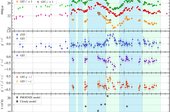 IIA JUDHAJEET BASU
IIA JUDHAJEET BASUDiscovery and detailed study of the M31 Classical Nova AT 2023tkw: evidence for internal shocks
We present a detailed analysis of an extragalactic slow classical nova in M31 exhibiting multiple peaks in its light curve. Spectroscopic and photometric observations were used to investigate the underlying physical processes. Shock-induced heating events resulting in the expansion and contraction of the photosphere are likely responsible for the observed multiple peaks. Deviation of the observed spectrum at the peak from the models also suggests the presence of shocks. The successive peaks occurring at increasing intervals could be due to the series of internal shocks generated near or within the photosphere. Spectral modeling suggests a low-mass white dwarf (WD) accreting slowly from a companion star. The ejecta mass, estimated from spectral analysis, is ~10−4 M⊙, which is typical for a slow nova. We estimate the binary, by comparing the archival Hubble Space Telescope data and eruption properties with stellar and nova models, to comprise a 0.65 M⊙ primary WD and a K iii cool evolved secondary star.
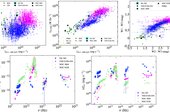 IIA STALIN, C. S
IIA STALIN, C. SDA 362: a gamma-ray-emitting compact symmetric object
The γ-ray detection from an astrophysical object indicates the presence of an extreme environment where highenergy radiation is produced. With the continuous monitoring of the γ-ray sky by the Fermi Large Area Telescope (LAT) leading to deeper sensitivity, high-energy γ-ray emission has now been detected from a diverse class of jetted active galactic nuclei (AGNs). Here, we present the results of a multiwavelength study of the radio source DA 362, which was reported to be a blazar candidate of uncertain type. However, it was recently identified as a bona fide compact symmetric object (CSO) based on its subkiloparsec, bipolar radio morphology, and lack of radio variability. This makes DA 362 only the fourth γ-ray-emitting object of this enigmatic class of radio-loud AGNs. Using five very-long-baseline interferometry observations covering 1996–2018, we found the jet separation velocity to be subluminal (vapp ~ 0.2c), thus supporting its CSO nature. Its Fermi-LAT observations revealed a γray flaring activity, a phenomenon never detected from the other three γ-ray-detected CSOs. This object is bright in the near-infrared band but extremely faint in the optical-UV filters, hinting at possible obscuration. Swift X-Ray Telescope observation of DA 362 reveals an extremely hard X-ray spectrum, though a strong claim cannot be made due to large uncertainties. We conclude that deeper observations are needed to probe the broadband properties of this enigmatic object and to understand the origin of high-energy γ-ray emission
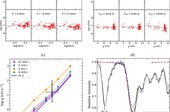 IIA PANDEY, G
IIA PANDEY, GDetection of enhanced germanium in a new cool extreme helium star A980: insights and implications
A fine abundance analysis of a recently discovered hydrogen-deficient carbon (HdC) star, A980, is presented. Based on the observed high-resolution optical spectrum, we ascertain that A980 is a cool extreme helium (EHe) star and not an HdC star. Singly ionized germanium Ge II lines are identified in A980’s optical spectrum. These are the first-ever detections of germanium lines in an EHe star's observed spectrum and provide the first measurements of germanium abundance in an EHe star. The overabundance of germanium in A980’s atmosphere provides us with evidence for the synthesis of germanium in EHe stars. Among the known cool EHe stars, A980 exhibits a maximum enhancement of the s-process elements based on a significant number of transitions. The measured elemental abundances reveal signs of H-burning, He-burning, and specifically the nucleosyntheses of the key elements Ge, Sr, Y, Zr, and Ba. The nucleosyntheses of these key elements are discussed in light of asymptotic giant branch evolution and the expectation from the accretion of an He white dwarf by a C–O white dwarf or by a neutron star
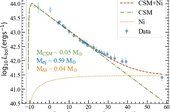 IIA SAHU, D. K
IIA SAHU, D. KSN 2023tsz: a helium-interaction-driven supernova in a very low-mass galaxy
SN 2023tsz is a Type Ibn supernova (SN Ibn), an uncommon subtype of stripped-envelope core-collapse supernovae (SNe), discovered in an extremely low-mass host. SNe Ibn are characterized by narrow helium emission lines in their spectra and are believed to originate from the collapse of massive Wolf–Rayet (WR) stars, though their progenitor systems still remain poorly understood. In terms of energetics and spectrophotometric evolution, SN 2023tsz is largely a typical example of the class, although line profile asymmetries in the nebular phase are seen, which may indicate the presence of dust formation or unshocked circumstellar material. Intriguingly, SN 2023tsz is located in an extraordinarily low-mass host galaxy that is in the second percentile for stripped-envelope SN host masses and star formation rates (SFRs). The host has a radius of 1.0 kpc, a g-band absolute magnitude of −12.72 ± 0.05, and an estimated metallicity of log(Z∗/Z) ≈ −1.6. The SFR and metallicity of the host galaxy raise questions about the progenitor of SN 2023tsz. The low SFR suggests that a star with sufficient mass to evolve into a WR would be uncommon in this galaxy. Further, the very low metallicity is a challenge for single stellar evolution to enable H and He stripping of the progenitor and produce an SN Ibn explosion. The host galaxy of SN 2023tsz adds another piece to the ongoing puzzle of SNe Ibn progenitors, and demonstrates that they can occur in hosts too faint to be observed in contemporary sky surveys at a more typical SN Ibn redshift
 IIA STALIN, C. S
IIA STALIN, C. SX-ray timing and spectral characteristics of compact symmetric objects
Compact Symmetric Objects (CSOs) are a distinct category of jetted active galactic nuclei whose high-energy emission is not well understood. We examined the X-ray characteristics of 17 bona fide CSOs using observations from Chandra, XMM-Newton and NuSTAR. Among the sources with XMM-Newton observations, we found two sources, J0713+4349 and J1326+3154 to show clear evidence of variations in the soft (0.3-2 keV), the hard (2-10 keV) and the total energy (0.3-10 keV) bands with the normalised excess variance (Fvar) as large as 1.17±0.27. Also, the Fvar is found to be larger in the hard band relative to the soft band for J1326+3154. From the analysis of the hardness ratio (HR) with count rate, we found both sources to show a harder when brighter (HWB) trend. Similarly, in the Chandra observations, we found one source, J0131+5545, to show flux variations in the total energy band (0.5-7 keV). We discuss possible reasons for about 82percnt of the CSOs being non-variable. From spectral analysis, carried out in a homogeneous manner, we found the existence of obscured as well as unobscured CSOs. Three CSOs, J0111+3906, J1407+2827 and J2022+6136, were found to have the intrinsic neutral hydrogen column density NH, z > 1023 cm-2, consistent with earlier analyses. For the majority of the CSOs, the observed hard X-ray emission is expected to be dominated by their mildly relativistic jet emission. For the sources, J0713+4349, J1347+1217, J1407+2827, J1511+0518 and J2022+6136, the confirmed detection of Fe Kα emission line suggests a significant contribution from the disk/corona. Our results point to diverse X-ray characteristics of CSOs.
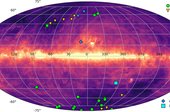 IIA JAYANT MURTHY
IIA JAYANT MURTHYExcess ultraviolet emission at high galactic latitudes: a new horizons view
We present new observations of the cosmic ultraviolet background (CUVB) at high Galactic latitudes (|b| > 40o ), made using the Alice UV spectrograph on board the New Horizons spacecraft. These observations were taken at about 57 au from the Sun, outside much of the foreground emission affecting previous missions, and allowed a new determination of the spectrum of the CUVB between 912–1100 Å and 1400–1800 Å. We found a linear correlation between the CUVB and the Planck E(B − V) with offsets at zero-reddening of 221 ± 11 photon units at 1000 Å and 264 ± 24 photon units at 1500 Å (4.4 ± 0.2 nW m−2 sr−1 at 1000 Å and 5.3 ± 0.5 nW m−2 sr−1 at 1500 Å). The former is the first firm detection of the offset in the range 912–1100 Å while the latter result confirms previous results from the Galaxy Evolution Explorer, showing that there is little emission from the solar system from 1400 to 1800 Å. About half of the offset may be explained by known sources (the integrated light of unresolved galaxies, unresolved stars, emission from ionized gas, and two-photon emission from warm hydrogen in the halo) with the source of the remaining emission as yet unidentified. There is no detectable emission below the Lyman limit with an upper limit of 3.2 ± 3.0 photon units
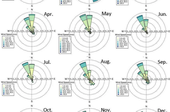 IIA RAVINDRA, B
IIA RAVINDRA, BStudy of wind pattern at the incursion site of Pangong Tso near Merak village
This study analyzes twelve years of wind speed and direction data collected at the proposed National Large Solar Telescope (NLST) site near Pangong Tso, Merak village, Leh-Ladakh. A weather station from Campbell Scientifc Instruments, installed in 2008, has been continuously monitoring meteorological parameters, including wind speed and direction. The data reveals a consistent pattern of predominantly northwest winds, particularly during morning hours, with speeds generally below 5 m/s. While seasonal variations infuence wind speed and direction, the overall trend remains stable. To assess the site’s suitability for astronomical observations, we compared high-altitude wind speeds at various renowned astronomical sites using reanalysis data from 2008 to 2020. Strong correlations were observed between surface and high-altitude wind speeds at 10 m, 50 m, and 500 m. Statistical analysis of 200-mbar pressure level wind speeds identifed La Palma as the most favorable site with a wind speed of 18.76 m/s. La Silla, on the other hand, exhibited the highest wind speed at 34.76 m/s. Merak’s estimated wind speed of 30.99 m/s, coupled with its favorable wind direction and low surface wind speeds, suggests its potential as a promising site for astronomical observations